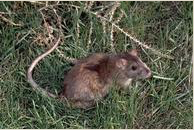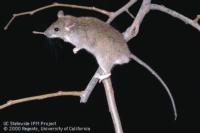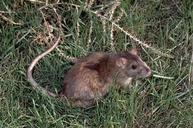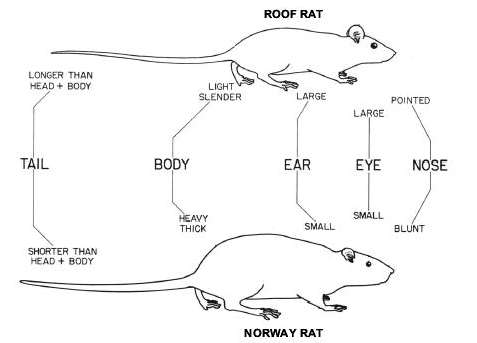Getting Rid of Rats
-
Rats are among the most common pests in Marin County, wreaking havoc in the home and garden. They also elicit some of the most visceral reactions from gardeners, who find their beady-eyed presence downright creepy. Fortunately, there are many strategies to both prevent and eradicate rats. The first step is to understand how and why rats show up and what they need to survive.
Know your enemy.
Norway rat
Norway rats (Rattus norvegicus), also known as brown, sewer, or wharf rats, have a blunt nose and a tail that's shorter than their body. Moving in an area up to 150 feet in diameter, Norway rat burrows along building foundations, beneath rubbish or woodpiles, in moist areas, and in gardens and fields. Indoors, they usually frequent the ground floor or the basement. Mostly nocturnal, their poor eyesight is offset with keen senses of hearing, smell, taste, and touch. They constantly explore and learn about their environment, memorizing pathways, obstacles, and locations of food and water. Norway rats memorize pathways, obstacles, and locations of food and water. Photo: UC Integrated Pest Management
Norway rats memorize pathways, obstacles, and locations of food and water. Photo: UC Integrated Pest ManagementRoof rat
Roof rats (Rattus rattus), sometimes called black or tree rats, are smaller than Norway rats. They have pointed muzzles and tails longer than their head and body combined. Roof rats are agile climbers and usually live and nest above ground in shrubs, trees (they particularly like palms) and dense vegetation such as ivy, honeysuckle, and blackberries. With their excellent sense of balance, they run along overhead utility lines or fence tops at night, traveling up to 300 feet for food. Inside, they can be found in attics, walls, false ceilings, and cabinets. Roof rat
Roof ratNative wood rat
Our native wood rats (Neotoma spp) are generally not pests. Wood rats have hairy tails and large ears. They build nests above ground from sticks, twigs, plant materials, and man-made debris, hence their common name of "pack rats." Norway rat
Norway ratThe following diagram will help you identify the characteristics of Norway and Roof rats:

Signs of a rat infestation
You are not likely to see rats, just their damage. Rats leave many clues that they've invaded:
- Large comma-shaped droppings
- Pitter-patter of tiny but speedy feet across your roof at dusk or dawn
- Birdseed that disappears overnight
- Chunks missing from tomatoes and other edible crops
- Gnawed plastic and resin food containers, electrical wires, doors, walls, and insulation
- Burrowing types can undermine building foundations and slabs
- Rats eat almost any type of food: fruits, nuts, pet and bird food, fresh grain, meat and fish, even slugs and snails
How to prevent a rat problem
Like most living creatures, rats need food, water, and shelter to survive. They often show up in search of one or more of these requirements and end up staying when they find it. This is especially true when they find a food source. Here are some common ways to make your home and garden unfriendly to rats:
- Harvest or pick up fallen fruit, nuts, and vegetables as they ripen.
- Feed your pets during daylight and remove uneaten food right away.
- Keep garbage and recycling cans covered.
- Store bulk foods, birdseed, and dry pet food in covered metal containers as rodents can chew through plastic or resin containers.
- Use rodent-proof birdfeeders.
- Remove excess garden debris.
- Trim trees, shrubs, and vines to at least four feet away from roofs and utility poles.
- Thin heavy vegetation from around buildings or fences.
- Stack wood and household items at least 18 inches above the ground and 12 inches from fences and walls.
- Seal any opening larger than the size of a dime with rodent-proof material such as metal, hardware cloth, mortar, concrete, or copper mesh wool.
- Weatherstrip front, side, and garage doors so they close tightly.
- Keep your garage door closed as much as possible.
- Repair damaged ventilation screens.
How to manage a rat infestation
Use traps
Trapping is an environmentally safe and effective method of eliminating rats. Large snap traps are inexpensive and reusable. Trap placement and location is crucial for effectiveness. Place traps in natural travel ways so the rodents have to pass over them. Put the short side of the trap containing the trigger against the wall or runway. Setting multiple traps 10 to 20 feet apart improves the odds of catching one. Using gloves, bait the trap with nuts, dried fruit, pet food, peanut butter, or bacon and secure it to the trigger with light string, fine wire, or even glue. You can improve your trapping success by leaving traps unset with unsecured bait until the bait has been taken at least once.
Invite natural predators
Birds of prey, especially barn owls, enjoy a steady diet of rats and other rodents. Adding an owl box to your neighborhood is an effective way to invite these welcomed predators.
Avoid toxins
There are many poison bait products that kill rats. Unfortunately, these products can also inadvertently injure or kill predators (cats, dogs, owls, hawks, fox, bobcats, coyotes, etc.) that might eat a poisoned rat. Symptoms of poisoning may take hours or days to see. When used indoors, the animal may die within wall or attic spaces resulting in significant odor problems and a swarm of flies.
Be safe
Rats are potential vectors of disease. Do not touch a dead rat with your bare hands and wash hands thoroughly after handling traps. Always wear protective gloves while removing a dead rat, place it in a plastic bag, seal it, and discard in your garbage can.
Dig deeper
Learn more about how to get rid of rats from the University of California Integrated Pest Management online resource. The The Marin/Sonoma Mosquito and Vector Control District is another good source of rat control information.
Original article written by Nanette Londeree and Marie Narlock
Edited for the Leaflet by Lisa MacCubbin




